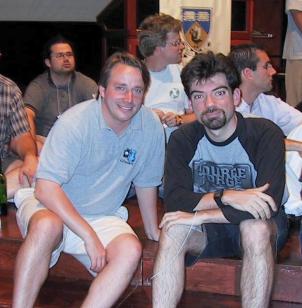| 2008/11/12 MythTVs | ||
|
π
2008-11-12 01:01
in Linux
|

Here is a list of older linux event reports I made before my blog was started, then the rest are below
| 1996/11/18-21: | Linux Pavillion Comdex Fall 1996 (photos only). I've been going since then to help at the linux pavillion. |
| 1997/11/18-21: | Linux Pavillion Comdex Fall 1997 (photos only) |
| 1998/05/28-30: | Linuxexpo 1998 (photos only) |
| 1998/11/16-20: | Linux Pavillion Comdex Fall 1998 (full report) |
| 1998/11/11: | Silicon Valley Tea Party (report with pictures) |
| 1999/02/15: | Windows Refund Day (report with pictures) |
| 1999/03/20: | SVLUG KTEH night (photos only) |
| 1999/03/01-04: | LinuxWorld Expo Winter 99 (complete report with many pictures) |
| 1999/03/31: | Mozilla Party one year anniversary (photos only) |
| 1999/05/18-22: | Linuxexpo 1999 (complete report with many pictures) |
| 1999/06/07: | June 99 Balug meeting with Linus |
| 1999/08/09-12: | LinuxWorld Expo Summer 99 (complete report with many pictures) |
| 1999/11/15-19: | Linux Business Show at Comdex Fall 1999 (full report with pictures) |
| 2000/08/14-17: | LinuxWorld Expo Summer 2000 (complete report with many pictures) |
| 2001/01/17-20: | Linux.conf.au/LCA 2001 (complete report with pictures) |
| 2001/07/25-28: | OLS 2001 (photos only) |
| 2001/08/25: | Linux 10th Anniversary (report with pictures) |
| 2001/09/27-30: | LinuxWorld Expo Summer 2001 report with pictures) |
| 2001/11/05-10: | ALS 2001 (photos only) |
| 2002/06/26-29: | OLS 2002 (photos only) |
| 2003/01/20-25: | LCA 2003 (photos only) |
| 2003/07/23-26: | OLS 2003 (photos only) |
| 2004/01/12-17: | LCA 2004 (photos only) |
| 2004/07/21-24: | OLS 2004 (photos only) |
| 2005/04/18-23: | LCA 2005 (photos only) |
| 2006/01/24-28: | LCA 2006 (photos only) |
| 2007/01/17-21: | LCA 2007 (photos only) |
Here is a list of all the talks I've given:
And below are my blog posts:
| 2008/11/12 MythTVs | ||
|
π
2008-11-12 01:01
in Linux
|
| 2008/11/29 Solved Disk Array Instability | ||
|
π
2008-11-29 01:01
in Linux
|
| 2008/11/29 Ubuntu Intrepid Ibex Upgrade From Hell and Network Manager Sucks | ||
|
π
2008-11-29 01:01
in Linux
|
| 2008/11/30 Magic Motherboard Crash And Raid Rebuild With DD Rescue | ||
|
π
2008-11-30 01:01
in Linux
|